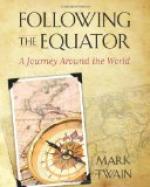“I saw the same man leap from the ground, and in going over he dipped his head, unaided by his hands, into a hat placed in an inverted position on the top of the head of another man sitting upright on horseback—both man and horse being of the average size. The native landed on the other side of the horse with the hat fairly on his head. The prodigious height of the leap, and the precision with which it was taken so as to enable him to dip his head into the hat, exceeded any feat of the kind I have ever beheld.”
I should think so! On board a ship lately I saw a young Oxford athlete run four steps and spring into the air and squirm his hips by a side-twist over a bar that was five and one-half feet high; but he could not have stood still and cleared a bar that was four feet high. I know this, because I tried it myself.
One can see now where the kangaroo learned its art.
Sir George Grey and Mr. Eyre testify that the natives dug wells fourteen or fifteen feet deep and two feet in diameter at the bore—dug them in the sand—wells that were “quite circular, carried straight down, and the work beautifully executed.”
Their tools were their hands and feet. How did they throw sand out from such a depth? How could they stoop down and get it, with only two feet of space to stoop in? How did they keep that sand-pipe from caving in on them? I do not know. Still, they did manage those seeming impossibilities. Swallowed the sand, may be.
Mr. Chauncy speaks highly of the patience and skill and alert intelligence of the native huntsman when he is stalking the emu, the kangaroo, and other game:
“As he walks through the bush his step is light, elastic, and noiseless; every track on the earth catches his keen eye; a leaf, or fragment of a stick turned, or a blade of grass recently bent by the tread of one of the lower animals, instantly arrests his attention; in fact, nothing escapes his quick and powerful sight on the ground, in the trees, or in the distance, which may supply him with a meal or warn him of danger. A little examination of the trunk of a tree which may be nearly covered with the scratches of opossums ascending and descending is sufficient to inform him whether one went up the night before without coming down again or not.”
Fennimore Cooper lost his chance. He would have known how to value these people. He wouldn’t have traded the dullest of them for the brightest Mohawk he ever invented.
All savages draw outline pictures upon bark; but the resemblances are not close, and expression is usually lacking. But the Australian aboriginal’s pictures of animals were nicely accurate in form, attitude, carriage; and he put spirit into them, and expression. And his pictures of white people and natives were pretty nearly as good as his pictures of the other animals. He dressed his whites in the fashion of their day, both the ladies and the gentlemen. As an untaught wielder of the pencil it is not likely that he has had his equal among savage people.




